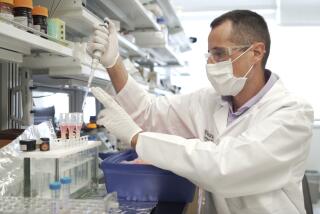Could a blood test detect concussion with lasting disability?
- Share via
The problem with diagnosing concussion, or mild traumatic brain injury, is that, well, you can seldom do it with any certainty. You can get witness reports that someone has had a blow to the head. You can find out whether she lost consciousness and-or experienced symptoms such as nausea, dizziness, headaches or confusion. You can even do a radiological scan to see if there’s any sign of swelling or bleeding in the brain. But no single alignment of yes-or-no answers or scan results is very good at telling you whether the brain has been hurt sufficiently to cause ongoing neurological problems.
A new study identifies a protein that could serve as a simple “biomarker” of more serious brain injury when even a brain scan fails to detect any such sign. The protein is a calpain-cleaved alphaII-spectrin proteolytic fragment that goes by the moniker SNTF, and it is released from neurons that are degenerating.
SNTF is easy to detect after an ischemic stroke or a major brain trauma. But researchers set out to explore whether much lower levels of SNTF in the bloodstream of concussed patients could help distinguish between the trauma victim whose brain has sustained a blow from which it will quickly recover and the one whose brain has sustained damage that could take months to heal.
In a small group of study subjects, they found that low but detectable levels of SNTF may help do just that.
Researchers writing in the journal Frontiers in Neurology report that in a small group of trauma victims -- 17 who went to the emergency room after brain trauma and 13 after orthopedic trauma -- immediate post-injury blood levels of SNTF that were twice the threshold of detection were associated with structural damage to the brain’s white matter -- the connective tissue that speeds electrical signals across and around the brain -- that was evident on diffusion tensor imaging. Compared with a healthy group of controls, the trauma victims with elevated SNTF also had cognitive problems that persisted three months after injury.
The power of SNTF as a blood biomarker for serious concussion will have to be tested in much larger populations before it can be considered a reliable tool in making a diagnosis. But if a quick and easy blood test could identify those with the most severe concussions, it could help ensure they get the extra time and help they may need to heal.
The authors of the study are from the University of Pennsylvania’s Perelman School of Medicine, Baylor College of Medicine, the Houston Veterans Administration Medical Center and Texas Children’s Hospital.







